Gowanus Community Gathers To Discuss Rezoning Framework With City Agencies
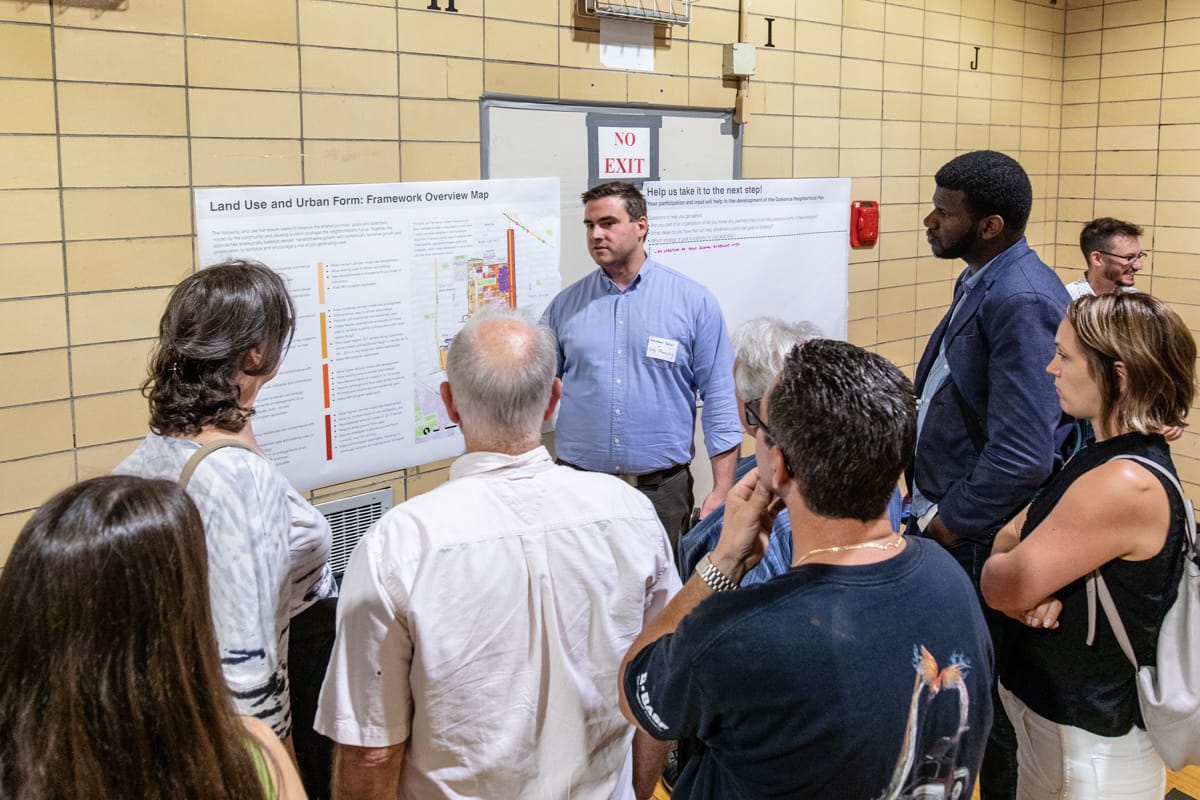
GOWANUS – The PS 32 gymnasium was packed Wednesday evening for an open house where community members from Gowanus and the surrounding neighborhoods could learn about and comment on the NYC Department of City Planning‘s (DCP) “Gowanus: A Framework for a Sustainable, Inclusive, Mixed-Use Neighborhood.”
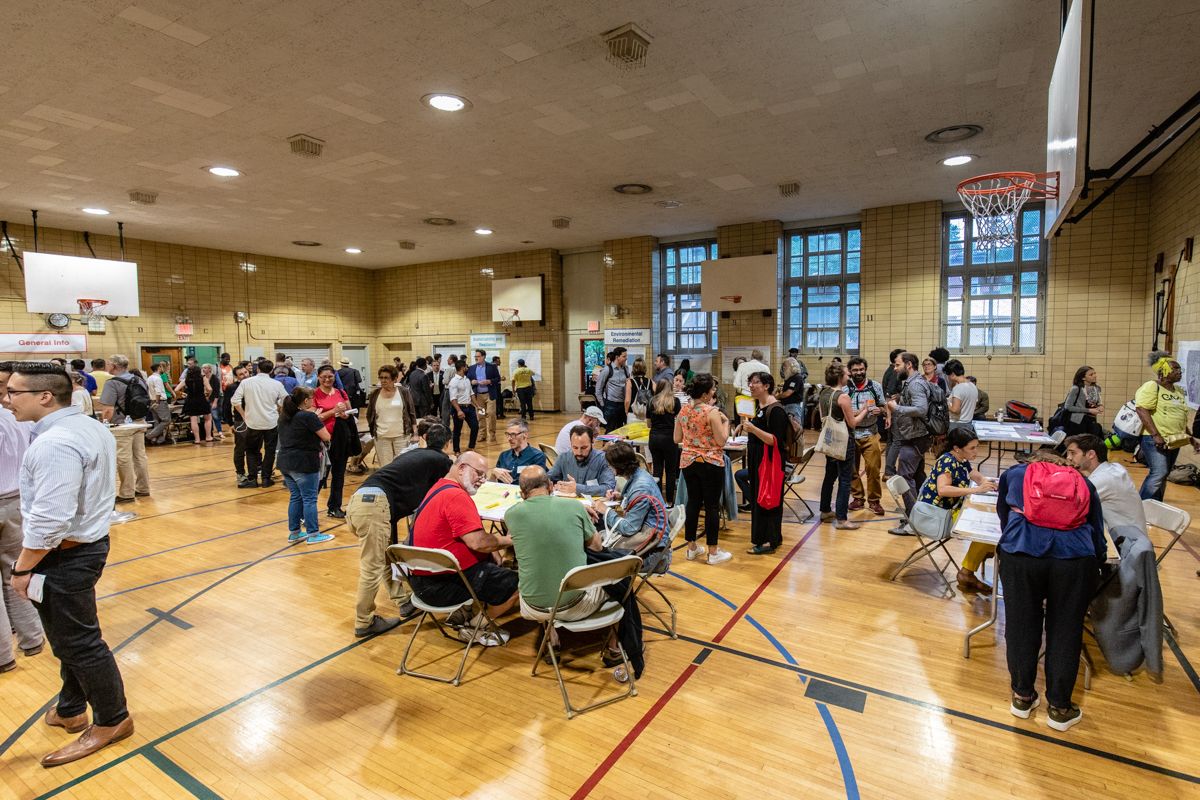
Released in early June after more than 100 hours of workshops and working group meetings, the Gowanus Framework outlines the goals and strategies the community and DCP have devised to make the Gowanus a thriving, resilient, and inclusive place to live and work.
The Framework focuses on community priorities which are divided into seven chapters: Sustainability and Resiliency; Environmental Remediation; Community and Cultural Resources (open space, schools, arts and culture, historic preservation); Housing (affordability and tenant protection, NYCHA, MIH or Mandatory Inclusionary Housing); Economic and Job Development (focusing on the Industrial Business Zone, or IBZ); Transportation; Land-Use and Urban Form (excluding the IBZ).
Wednesday’s meeting was set up convention-style, with booths focusing on the seven categories and manned by representatives from NYC agencies including the Office of the Mayor, NYC Emergency Management, Department of Environmental Protection, Office of Environmental Remediation, Department of Housing Preservation & Development, Small Business Services, NYC Economic Development Corporation, Department of Transportation, Department of Parks & Recreation, School Construction Authority, and of course, DCP. Each station had oversized Post-It notes for attendees to write their suggestions and comments.
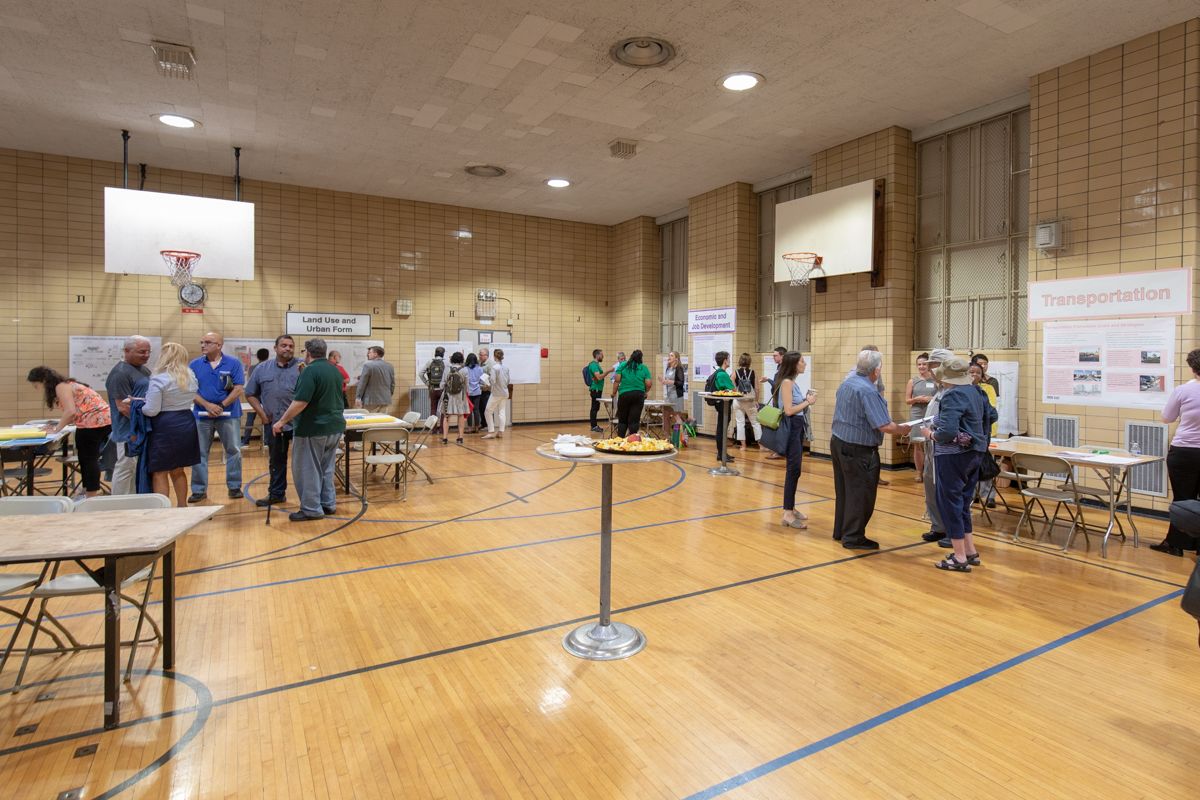
“I wanted to show up to be with my neighbors, to hear their thoughts, and also hear from the agencies in this open format because when you read [the Framework] on paper you can only get so much from it,” said Kathy Park Price, a Park Slope resident, CB6 Board member, and CEC 15 member. “I think it’s really important to show up and ask the questions and talk to the people who are making these decisions.”
Park said she felt “specifics were lacking in the Framework” regarding schools, so she spoke to a representative of the School Construction Authority and asked her for details about the Framework’s plan for schools. Park was informed that “hard numbers” (i.e., how many students will new housing introduce to the area) are needed before specifics on “school siting and planning” can be discussed.
Park also spoke to a DOT representative regarding the B71 bus. “I wanted to know if DOT was actively working with the MTA because in the Framework they say ‘Let’s bring back the bus.’ It’s great to say but is DOT working with the MTA in some capacity?” she questioned. Park was informed that the MTA was a no-show to the open house and was told, “We can’t work with them if they aren’t here.”
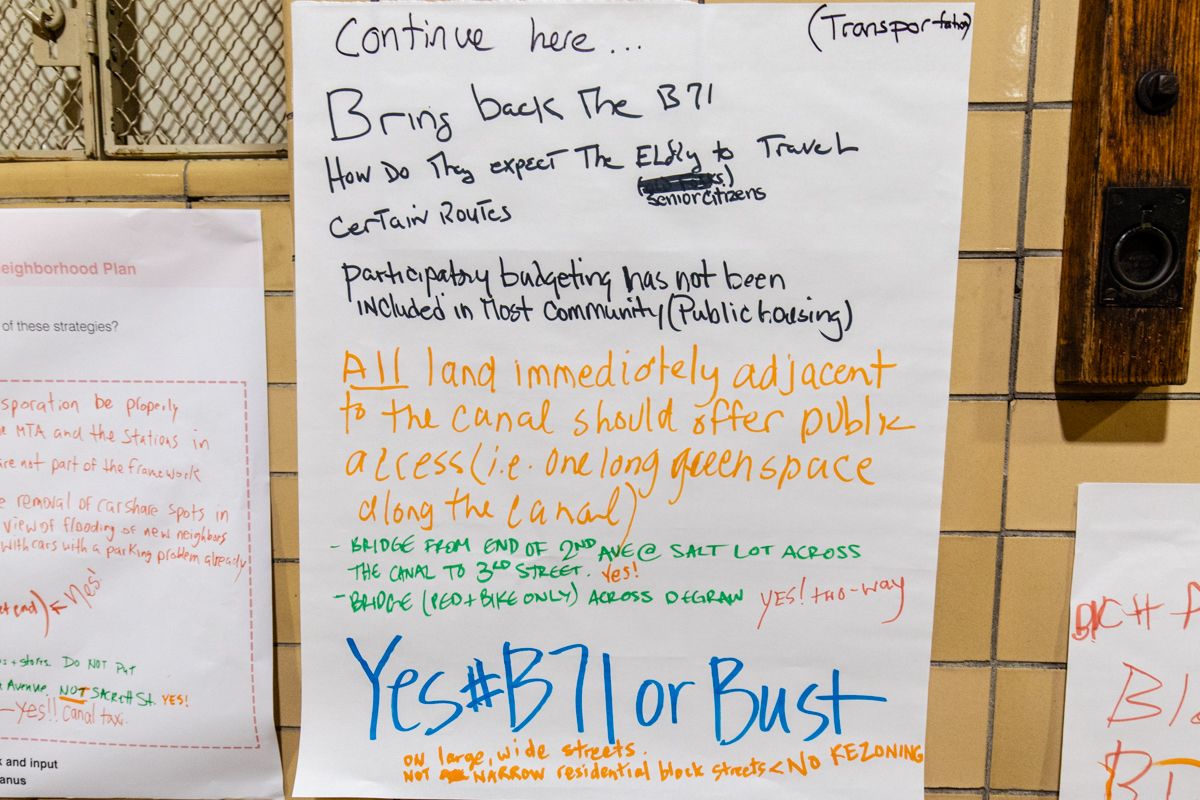
Overall, Park found the event helpful. “I was really excited to see the feedback that our community members left on the walls and the turn-out was amazing. I was energized by the community engagement and inspired by my neighbors,” she said enthusiastically.
Some were disappointed with the format of the event and would have preferred a presentation similar to the one DCP gave to CB6 on June 11 but with more detailed information. “The Gowanus Framework had been introduced and I wanted to see if there was going to be any more discussion or granular breakdown as to what is going to happen and this is more of like a meet-and-greet,” said Mark Shames, Chair of the CB 6 Environmental Protection Committee, who was assured that there will be subsequent meetings, presentations and discussions. “I would have preferred more of a formal presentation and a question-and-answer session,” he added.
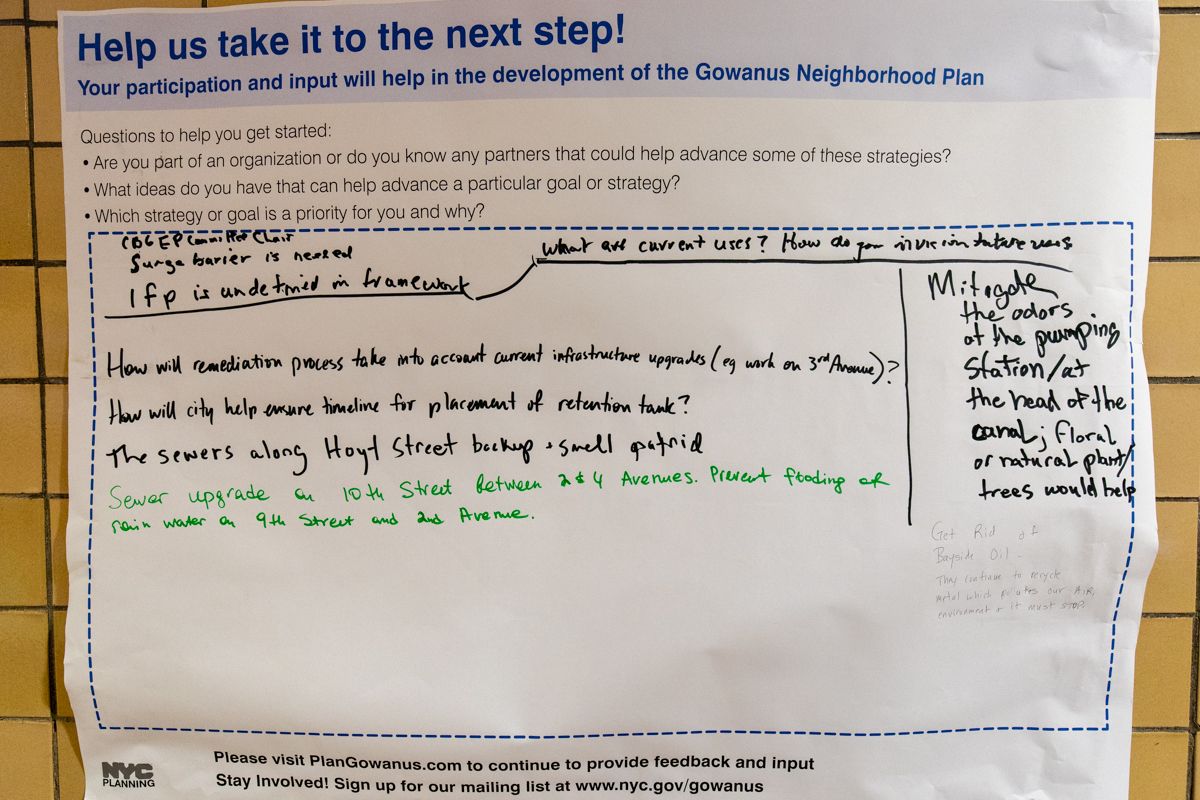
Among his priorities for the Framework, Shames would like to see a surge barrier installed at the head of the canal “because we are getting increased storm surge and that wasn’t really discussed,” he said. “There should be an integrated flood plan but there is no definition at all about what that integrated flood plan will or should be,” he added.
When asked how the city agency reps responded to his concerns, he said, “I think people are very receptive in trying to define [the integrated flood plan]. I think they’re non-committal on the surge barrier, it’s expensive.”
Shames also had questions regarding the future uses of the canal and whether they will be environmentally sound. “I mainly would like to see it as a recreational canal,” he noted. “I have long been supportive of the Gowanus Dredgers and the Gowanus Canal Conservancy.” He’d also like to see the lowlands park included in the plan and “maybe hav[e] a moveable floating performance space.”
“I’ve been a proponent of the rezoning forever,” Shames continued. “I don’t hide that fact. I’m not particularly loved by certain groups of people. This city is in desperate need of additional housing, particularly affordable housing….How much they do here and in what areas here, that has not yet been determined, but we need housing desperately. We need housing probably more than anything else.”
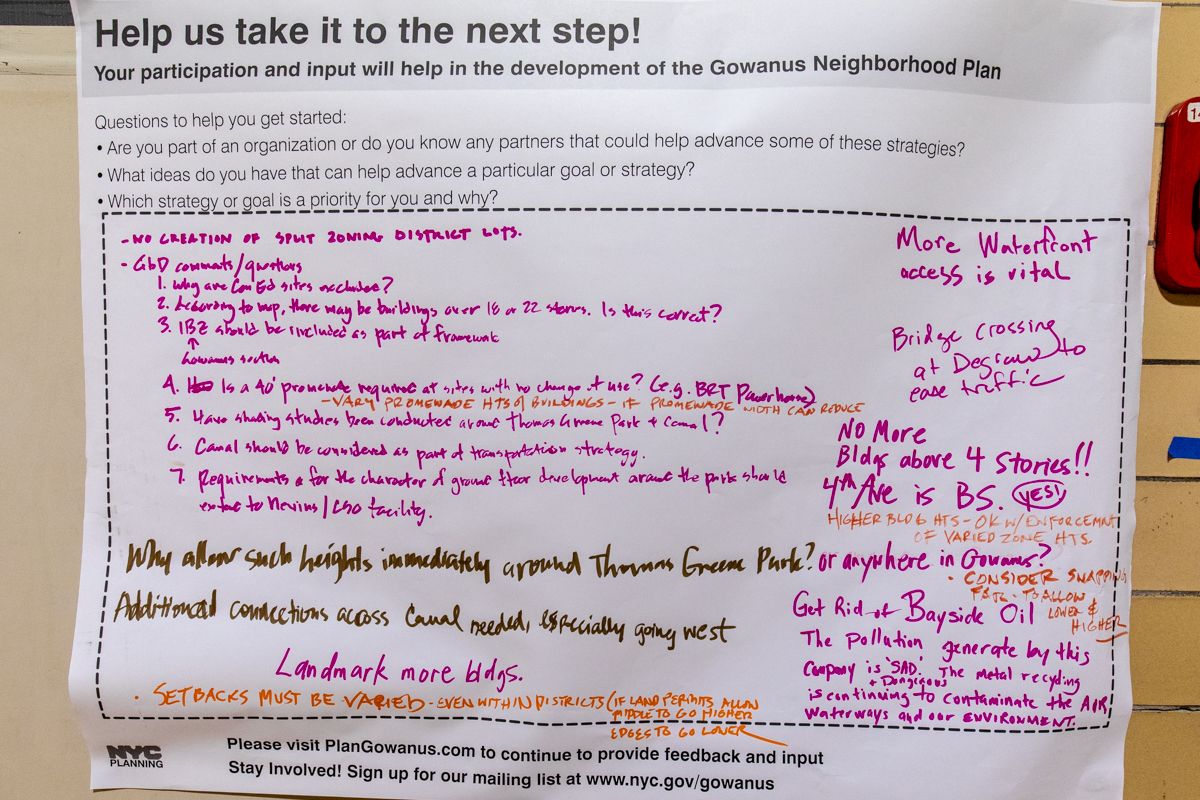
“First of all, I am thankful that we were able to push over the last several months to even get a mention about public housing in this framework,” said Karen Blondel, Red Hook resident and organizer for the 5th Avenue Committee‘s environmental initiative Turning the Tide, “but I don’t see any upfront commitments from them in regards to public housing.”
“I also feel like some of the stuff that they’re pointing to as commitments were already committed prior to the framework,” she noted, such as the reopening of the Gowanus Houses Community Center or the NextGen Neighborhood program which will put a 16-story mixed-income residential building on two parking lots at NYCHA’s Wyckoff Gardens, a plan “most residents in Wyckoff are in opposition to.”
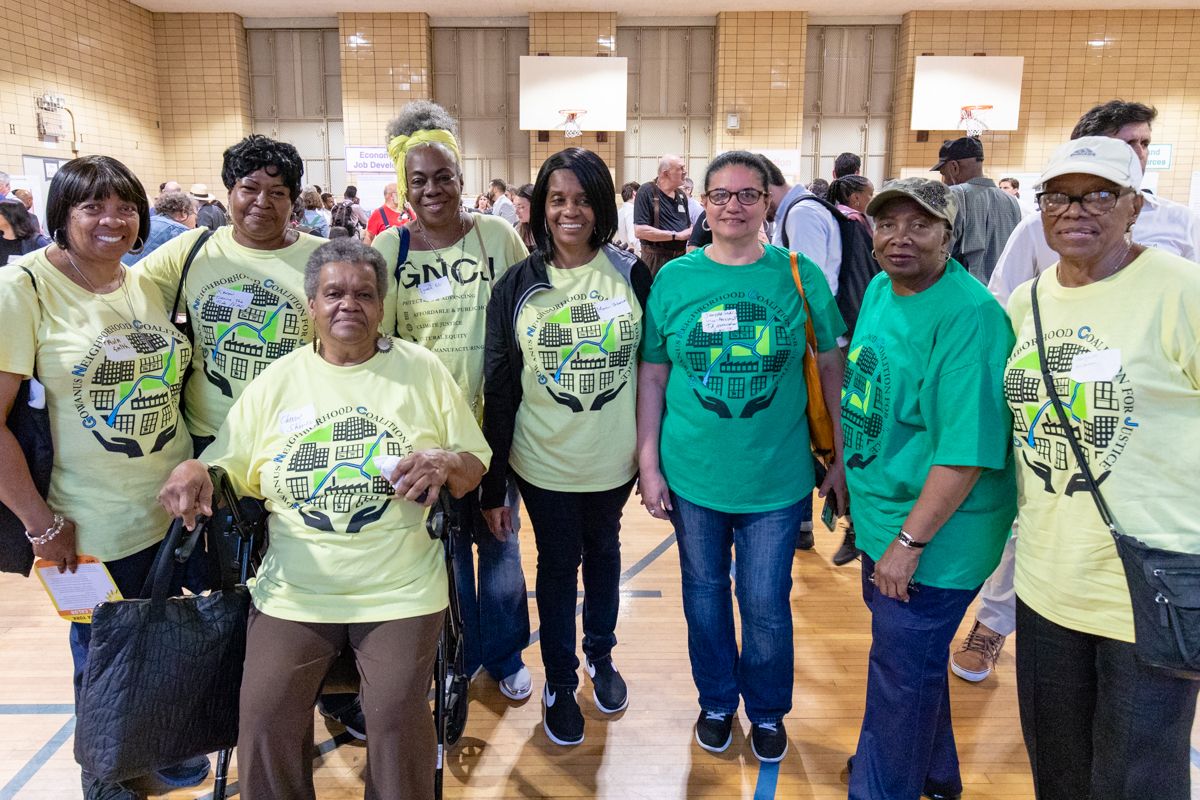
“I brought a whole team with me [from the Gowanus Neighborhood Coalition for Justice] and they are pretty well versed on this framework, so a lot of them are speaking to the issues that they feel are most affecting them,” Blondel said. “We just want to make sure that public housing is equitably dealt with.”
Another member of the Gowanus Neighborhood Coalition for Justice, Andrea Parker, is also the Executive Director of the Gowanus Canal Conservancy. “There’s a whole platform that we have that aims to make sure that we don’t all get siloed into our separate areas [by the Framework], but stand together as a community,” she said. “I think the big things that are missing right now from that platform are investments in the IBZ and in NYCHA,” she added.
In terms of the Gowanus Canal Conservancy—the environmental steward for the watershed and the Canal—Parker said, “It’s really important to make sure that any new development that happens doesn’t add to the pollution that we’re experiencing every time it rains in the canal. Any new toilets that are added to the watershed are going to add to that so we need to think carefully about what infrastructure can be built to manage that. That really needs to be baked into the Framework now.”
Parker and her team are suggesting smart solutions such as sensors that can be installed on buildings to control when their sewage gets released into the system and into the Canal. “There’s a lot of great technology and innovation that can happen here, and that’s going to need to happen in order to make it successful,” she said.
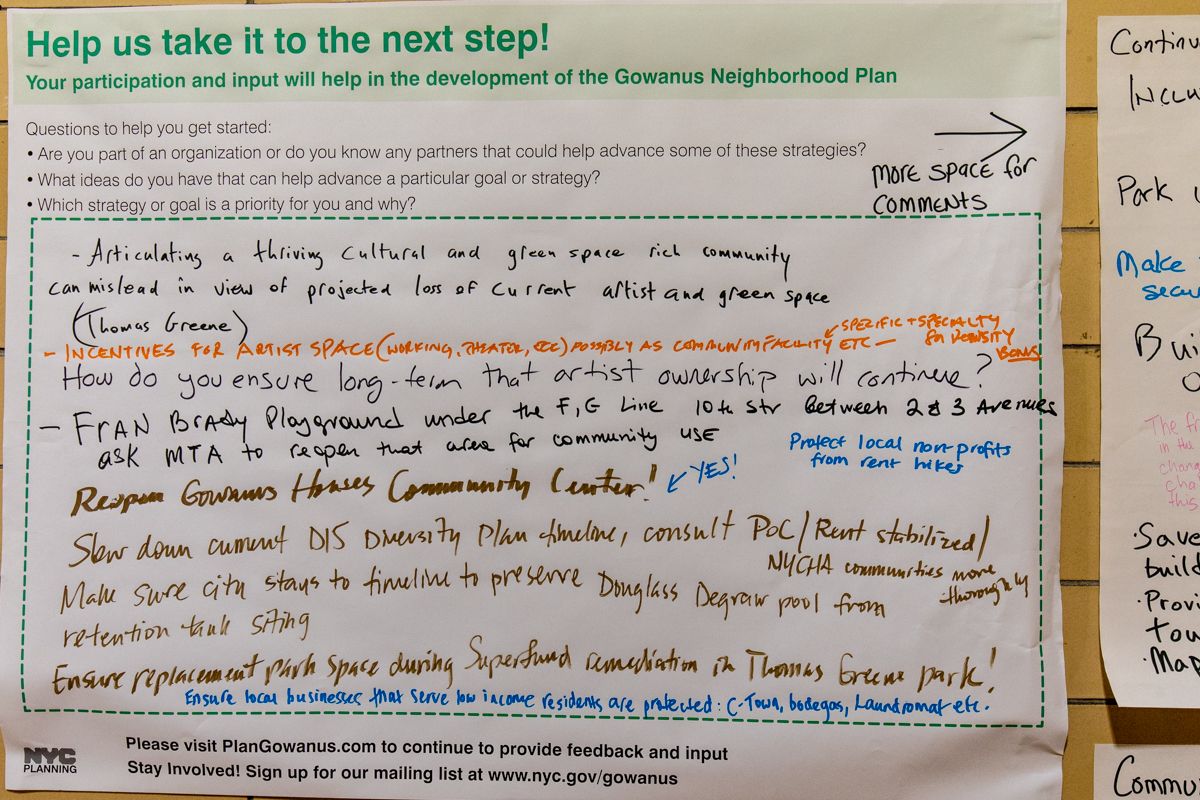
While excited about the Framework’s potential new open spaces, Parker noted, “We’re definitely going to need to make sure there is a long-term maintenance framework for that, specifically for any new work that the city is building because the city has not had a great track record with green infrastructure maintenance and that’s a real issue.”
Parker ended on an optimistic note, “It’s been great how much agency engagement we’ve had just with the ‘Places’ process. I think that in the Framework there are a lot of loose general promises that don’t have any teeth to them, so I think there is really a need that I hope starts tonight, but continues until the actual plan comes out, to really get some firm commitments behind all of the good intentions that are within the Framework.”
“The main reason for attending tonight is to continue to ask that the waterfront edge be considered. The entire report [has] no description at all of how the water is used by anyone,” said Owen Foote who founded the Gowanus Dredgers Canoe Club nearly 20 years ago. “It’s been discussed in many of the [‘Places’] meetings to have open, vibrant, enjoyable amenity spaces, and instead they continue to show these spaces that are open to the elements, and that’s disappointing to us.”
The Framework “fails to describe the shoreline or waterfront,” Foote wrote in a statement the day following the open house. “We ask that CB6 request a description of the waterway, its uplands and uses be included when the draft framework is revised and a final framework is published.”
During the open house, Foote passed out a land use map he created with the Dredgers highlighting opportunities they would like the DCP to incorporate into the next step of their process, the Draft Neighborhood Plan.
“We’ve gotten good early reception to the Framework. People are digesting it,” said DCP Project Manager Jonathan Keller. “There are still open questions because we don’t have the zoning that comes with densities, numbers that put traffic onto streets and in schools. There are still concerns and questions we will continue working on, but we are in the next step to getting there with a Draft Neighborhood Plan based on all this work by the end of the year.” The Draft Neighborhood Plan will include a Draft Zoning Proposal which will provide details and answers to many outstanding questions.

“There’s obviously a group that wants us to rezone the IBZ,” Keller continued. “We created an entire chapter in our Framework devoted to what goals and strategies we have that we want to tailor for the IBZ because we want to reinforce it as an industrial and commercial job center. We’ve put in our framework a specific goal and strategy around working with stakeholders [in the IBZ] to identify if additional land use interventions are needed for the IBZ,” he said.
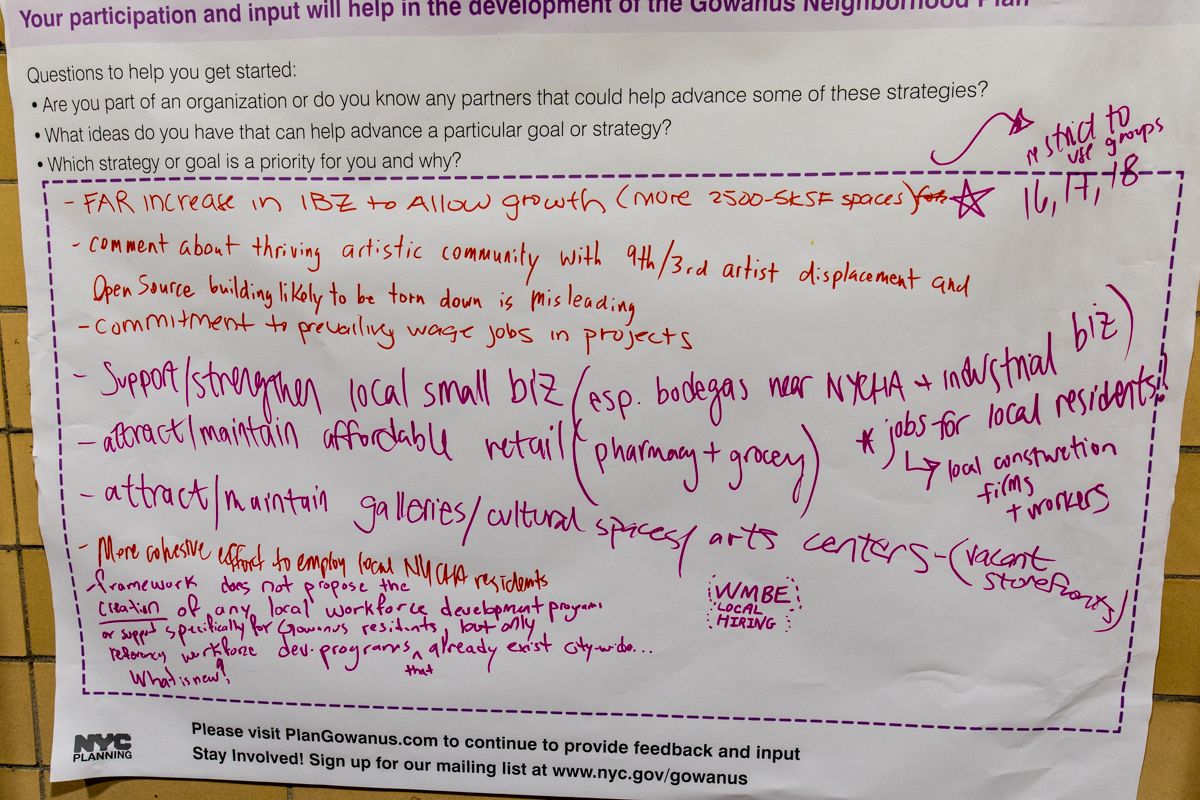
Keller explained that the IBZ was not included in the Land Use & Urban Form section of the Framework because rezoning for residential versus industrial/commercial is very different and doing a rezoning for the IBZ will require a “full, in-depth study and we don’t want to delay the rest of this, so we have been very reticent to expand our scope.”
“We’ve committed to figuring out if there are issues [within the IBZ], and if there are then we’ll keep moving forward with that,” he continued, noting that while the DCP works on the Draft Neighborhood Plan they will simultaneously begin to work with IBZ stakeholders on their land use concerns. “We’ve talked about what their needs are in the working groups in terms of infrastructure, parking, and operational [needs] but this will be more targeted.”
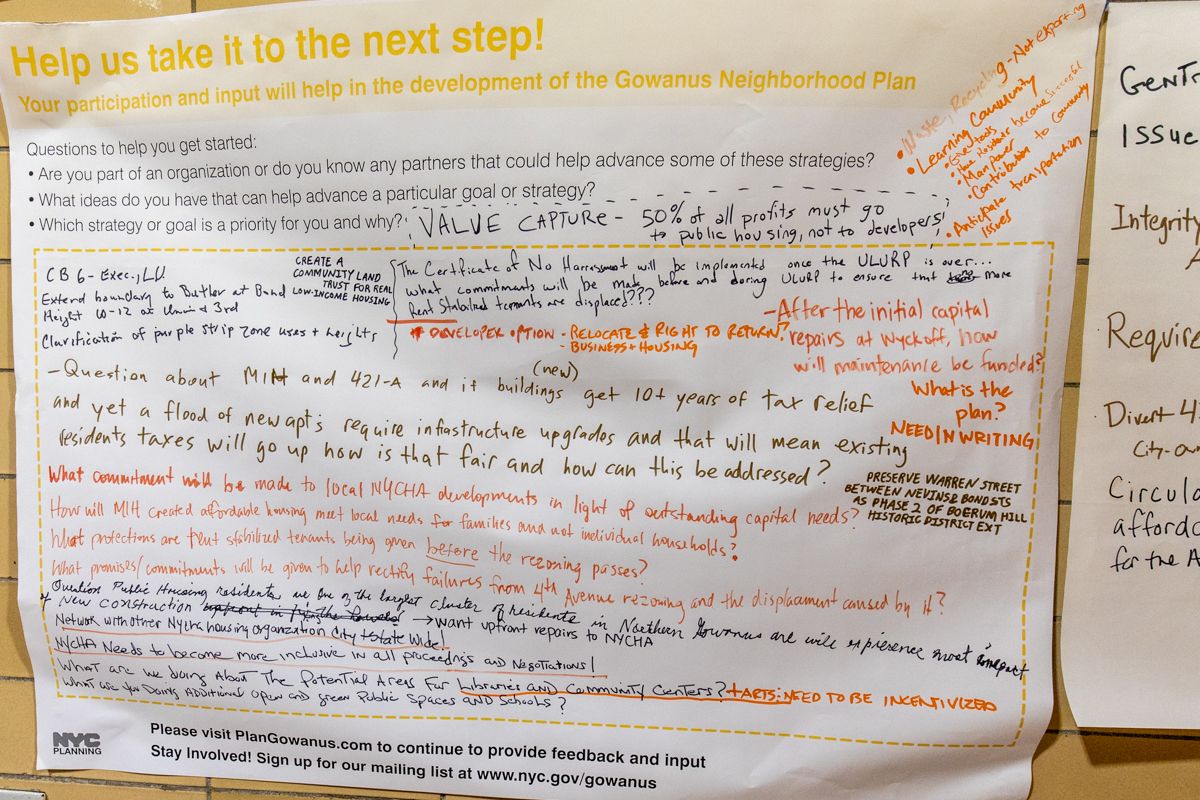
“I was just asking questions [tonight] about what it entails once they put the [NextGen] building up,” said Paula Smith who has lived at the Wyckoff Gardens since 1969. “They told us the money they collect, the rents, are supposed to go to NYCHA and that money is supposed to help keep up our buildings and [go toward] repairs and any work that needs to be done. I’m wondering if they’re just telling us this. They need a contract stating that they are going to do x, y, z.”
“We’re wondering about the future of our buildings and our neighborhood,” she continued, “but the neighborhood is changing anyway and there’s nothing we can do about that. We don’t want to be left out or relocated somewhere else or treated like we don’t exist.”
A workshop to discuss plans for the city-owned Public Place site will be scheduled in the Fall.
Community members can continue to submit their comments, feedback, and ideas to DCP either via email gowanus@planning.nyc.gov or PlanGowanus.com.
Click here to see the full “Gowanus: A Framework for a Sustainable, Inclusive, Mixed-Use Neighborhood.”




